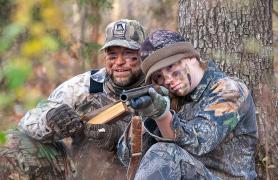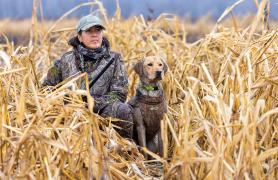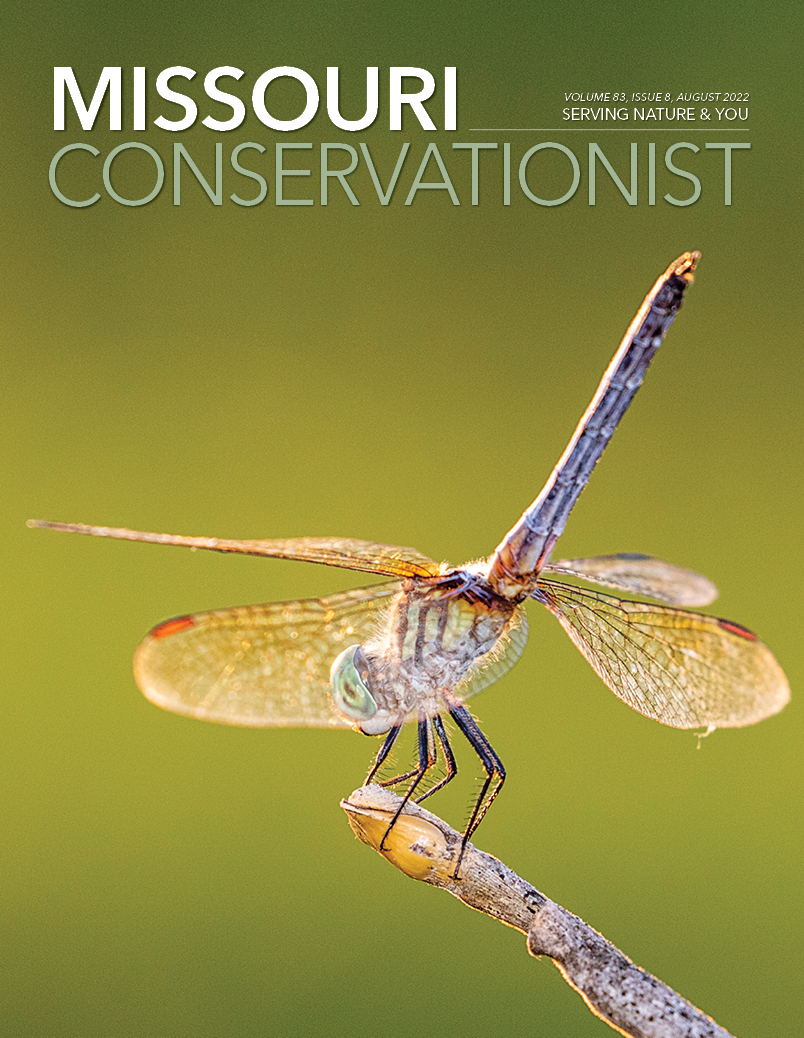
It’s a warm summer night and a couple sets out on a long moonlit walk, searching for a place to dine. Instead of using the latest Yelp reviews to find the hippest hotspot with the finest cuisine, this couple uses their chemical receptors located on their antennae. You see, this is no ordinary couple — this is a mated pair of American burying beetles. And this is no ordinary dinner — it’s a feast fit not for the faint of heart.
Meet the Beetles
American burying beetles (Nicrophorus americanus) are the largest of the carrion beetles, growing up to 1 to 1¼ inches long. They are shiny black with bright orange-red bands on their elytra, or wing covers. They also have a bright orange-red patch just behind the head and a patch between the eyes.
American burying beetles are nocturnal, getting the munchies at night. Using special chemical receptors located in their orange, knoblike antennae tips, they can detect dead, rotting animals from far away. In fact, they can pick up a carcass’ signal within an hour of its demise.
Their palettes are not discriminating either. Insects, mice, voles, opossums, birds, snakes, fish — they all show up on the beetles’ menu.
Food Handlers
American burying beetles aren’t picky when it comes to taste or size of their meal. However, size does matter when it comes to how their food is handled. Smaller, bite-sized morsels are eaten on the spot, while larger carcasses are used to nest and feed young.
Let’s return to the happy couple at the beginning of our story. Their antennae alert them to a dead quail in a field, and that’s where their moonlit stroll takes them. There, they may find other hopeful diners that they have to fight off, but ultimately, they come out victorious and their work begins.
Together, the male and female move their prize and bury it. This is no small feat. If the quail died on a hard piece of ground, the beetles must roll onto their backs, wiggle underneath the carcass, and use their legs to push it forward. When one beetle slides the quail off its body, the other runs to the front to take over for its partner. Millimeter by millimeter, the pair scoots the quail to softer soil for burial.
Burying beetles can move carcasses that weigh 200 times more than they do.
Race to the Grave
Nocturnal navigation becomes a race against time for this pair. The woods at night is patrolled by an army of thieves — raccoons, opossums, foxes, and coyotes — more than eager to snatch this quail for a meal. Sunrise is lurking and with it would bring scavenging vultures and squadrons of flies. The longer this quail lays exposed, the greater the chance it would be snatched away. So, the beetles do what they do best — start digging.
Both beetles must squeeze underneath the body and use their flat, hard heads to loosen the soil and push it out from under the quail. Bit by bit, the soil beneath the quail is excavated, and inch by inch the quail sinks into a shallow grave.
On average, American burying beetles bury their carcasses about 9 inches underground. Some go-getters dig down a foot or farther.
With the quail safely underground, the beetles remove all the feathers, using their strong jaw muscles and sharp pincers. In short order, the quail resembles a plucked chicken.
Setting Up the Nursery
Working together, the beetles roll the quail into a tight ball. Then they coat the corpse with a gooey liquid from their mouths and backsides. The goo helps slow the decay of the carcass, keeping it “fresh.” The female beetle scoops out a small chamber, which will become her nursery. There, she lays her eggs, typically 10–30.
Within four days, the eggs hatch into larvae, and now the nursery also serves as baby food. The larvae feed on the carcass with help from both parents. It’s rare for an insect to care for its young. It’s even rarer for both parents to pitch in, but burying beetles aren’t ordinary insects. Both parents feed their offspring by eating some of the dead flesh and regurgitating it into the larvae’s mouths. After 48 to 60 days, the new adults emerge to feed on other carcasses and the cycle continues. Adults typically live four to six months.
Community Service
American burying beetles perform a valuable service to the natural world. By burying dead animals, they help return nutrients to the soil. And by consuming dead animals, they lessen possible contact with decaying animal tissues, reducing disease among the living.
In addition, they are of great interest to science, which studies the beetles’ response to changing ecosystems. Also, by competing with fly maggots for food, they can help reduce populations of annoying flies.
Declining Populations
A hundred years ago, American burying beetles were found in 35 states, including Missouri. But, times have changed. Today, wild populations exist in only six states, and Missouri isn’t one of them.
What caused the beetles’ decline? Habitat loss is thought to be one cause. When people altered the landscape for farming and development, it changed the species that lived there. There were fewer animals that served as the beetles’ food, even as there were more carrion feeders to compete with the beetles.
“Another major factor is thought to be light pollution,” said Steve Buback, MDC natural history biologist. “American burying beetles are the only member of the genus that are nocturnal, thus affected by light pollution brought on by over-developed wild spaces.”
Besides habitat change, pesticides may have played a part in the beetles’ decline. As a result, the U.S. Fish and Wildlife Service (USFWS) listed the American burying beetle as a federally protected endangered species, the nation’s first insect ever to receive this designation.
The Saint Louis Zoo, the USFWS, MDC, and The Nature Conservancy began working together to change that.
“The beetle was last seen in Missouri in the mid-1970s,” said Bob Merz, assistant director of the Saint Louis Zoo WildCare Institute and director of the WildCare Institute Center for American Burying Beetle Conservation. “For the first decade of the 2000s, we monitored for existing American burying beetles but found none.”
As a result, the zoo began breeding beetles in captivity in 2004. The first mated pairs were released on June 5, 2012, in locations across the 4,040-acre Wah’ Kon-Tah Prairie Conservation Area in southwest Missouri.
“The released beetles were paired and marked by notching their elytra — the hard, modified forewings that encase the thin hind wings used in flight,” explained Kayla Garcia, zoological manager of invertebrates for the Saint Louis Zoo. “The notches would later distinguish captive-bred from wild beetles. The beetle release process involved digging holes, or plugs, at specially selected sites, placing the carcass of a quail and a pair of notched beetles in each cavity, and replacing the plugs. This process simulated a natural underground setting for the beetles’ life cycle. The plug sites were monitored for signs of breeding activity by checking for larvae, and later, new adult beetles.”
Since 2004, the zoo is consistently breeding beetles two times a year and reintroducing them as pre-paired mates once per year. The project has since expanded to include Taberville Prairie Conservation Area in El Dorado Springs.
“We know that our beetles are producing offspring on Wah’ Kon-Tah Prairie and that these offspring are surviving through the winter,” said Merz. “Our contribution to reintroduction efforts by returning the beetle to parts of its former range is the beginning of the recovery of this beautiful beetle.”
Due to these efforts, the American burying beetle has now been down listed from endangered to threated by USFWS and as a nonessential experimental population under the Endangered Species Act. This means the population has been reintroduced within its historical range, but USFWS has determined the population isn’t necessary for the continued existence of the species. As a result, this designation helps provide assurance to neighboring landowners that the reintroduction of the beetle will not impact farming and other activities and has no bearing on the delisting.
For more information about the American burying beetle and the efforts to reintroduce it to Missouri, visit short.mdc.mo.gov/4i6.












Also In This Issue

A monthly to-do guide to help you get the most out of Missouri’s hunting seasons

Study finds link between wetland usage, conservation efforts
And More...
This Issue's Staff
Editor - Angie Daly Morfeld
Associate Editor - Larry Archer
Photography Editor - Cliff White
Staff Writer - Kristie Hilgedick
Staff Writer - Joe Jerek
Staff Writer – Dianne Van Dien
Designer - Shawn Carey
Designer - Marci Porter
Photographer - Noppadol Paothong
Photographer - David Stonner
Circulation Manager - Laura Scheuler






















